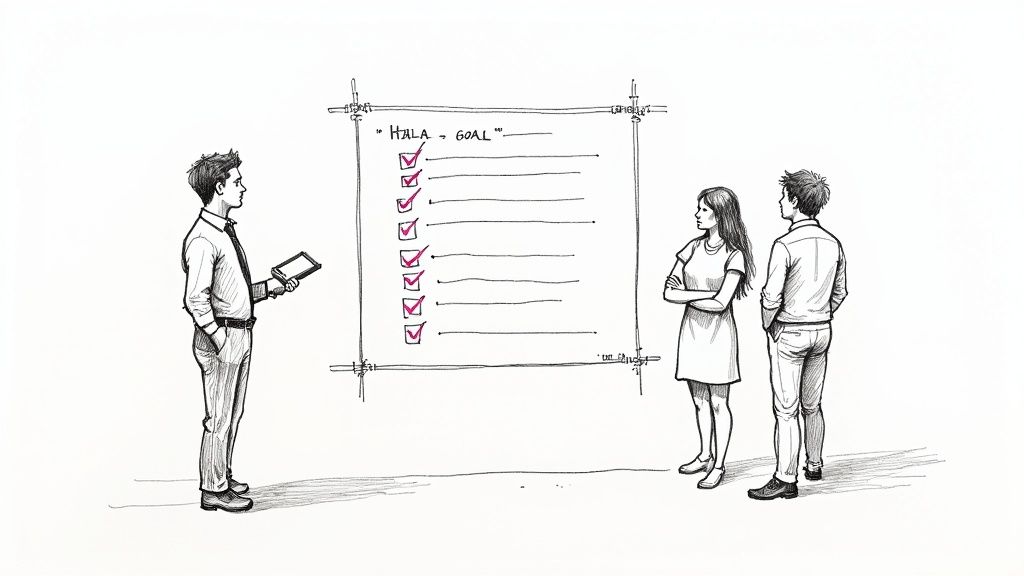Table of Contents
Promoting your best people into management roles should be a home run. But more often than not, it's a swing and a miss. The skills that made someone a rockstar individual contributor are almost entirely different from what's needed to lead a team. This is precisely why a well-designed first time manager training program isn't just a nice-to-have—it's a critical business investment.
Why Most New Manager Training Fails
Let’s be honest for a second. A lot of the manager training out there just doesn't work. Companies sink significant time and money into programs, only to see their new managers struggle and teams disengage. The problem usually boils down to a massive disconnect between what traditional training offers and what new leaders actually need on the ground.
Moving from an individual contributor to a manager isn't just a promotion; it's a fundamental career change. Too many organizations treat it like a simple next step, throwing new managers into a one-day workshop and expecting them to figure out the rest. This approach completely ignores the deep mindset shift required to succeed—the move from doing the work to leading others to do it. It glosses over the tough stuff: delegation, navigating conflict, and giving feedback that motivates instead of deflates.
The Staggering Cost of Unprepared Leaders
Failing to get this right comes with a hefty price tag. Research paints a pretty stark picture: a staggering 60% of new managers underperform or fail within their first 24 months. This isn't a minor hiccup; it's a major drag on your company's resources, productivity, and culture. You can dive deeper into this research and why manager programs are non-negotiable on GlobalGyan.in.
Ready to drive more growth & achieve bigger impact?
Leverage my 25+ years of successes and failures to unlock your growth and achieve results you never thought possible.
Get StartedWhen a new manager stumbles, the shockwaves are felt by their entire team. These are the all-too-common symptoms:
- Decreased Team Morale: An unsupported manager often swings between micromanaging every detail and being completely hands-off. Both extremes leave teams feeling confused, frustrated, and uninspired.
- Higher Employee Turnover: We’ve all heard it: people don't quit jobs, they quit bosses. The cost of replacing a talented employee often dwarfs the investment it would have taken to properly train their manager.
- Reduced Productivity: Without clear goals, constructive feedback, or smart resource management, a team's output grinds to a halt. Projects get stuck, and crucial deadlines are missed.
The real problem is that we promote people for being excellent at their craft, then expect them to be instinctively excellent at managing others—two completely different skill sets. Effective first time manager training bridges this critical gap.
Building a Program That Actually Works
The fix isn't another generic, "one-and-done" seminar. A program that creates real change is a continuous journey, not a single event. It has to be grounded in the day-to-day realities new managers face, focusing on practical skills they can apply immediately, not just abstract theories. You can find more insights on building effective leadership and management systems to support this journey in our management blog.
Before you even think about the curriculum, you need to understand what makes a program stick. The best ones are always built on a few core pillars that prepare new leaders for the messy, human side of management.
Here's a look at the essential components that should form the foundation of any program designed to help new managers thrive.
Ready to drive more growth & achieve bigger impact?
Leverage my 25+ years of successes and failures to unlock your growth and achieve results you never thought possible.
Get StartedCore Components of an Effective First Time Manager Training Program
| Component | Objective | Key Topics |
|---|---|---|
| Mindset Shift | Transition from individual contributor to team leader. | Identity shift, letting go of old tasks, focusing on team success over personal output. |
| Core People Skills | Build trust and communicate effectively with direct reports. | Active listening, giving and receiving feedback, running effective 1-on-1s. |
| Execution & Delegation | Empower the team to achieve results without micromanaging. | Setting clear expectations, delegating outcomes (not tasks), project management basics. |
| Leadership Identity | Develop a personal and authentic leadership style. | Emotional intelligence, conflict resolution, motivating different personalities. |
By focusing on these foundational areas, you move beyond a simple checklist of management duties. You start equipping your new leaders with the confidence and competence to not only succeed but to build teams that do the same.
Building Your Foundational Skills Curriculum
A great first-time manager program isn't about ticking off boxes on some generic HR checklist. It’s about building a curriculum that gets right to the heart of the toughest, most common challenges new leaders face. The goal is to skip the fluffy theory and hand them practical tools they can put to work the very next day.

Think of this curriculum as their survival guide for the first 90 days. It needs to be all about real-world application, turning abstract leadership concepts into skills they can actually use. Let's dig into the core modules you absolutely can't skip.
From Teammate to Manager
The most immediate—and often most jarring—change for a new manager is the identity shift. Yesterday they were a peer, a friend, maybe even the team confidant. Today, they're the boss. This is a minefield of emotional and psychological hurdles that, frankly, most training programs gloss over.
Ready to drive more growth & achieve bigger impact?
Leverage my 25+ years of successes and failures to unlock your growth and achieve results you never thought possible.
Get StartedYour curriculum has to tackle this head-on. Don't just tell them to adopt a "leader mindset." Show them how.
- Navigating New Dynamics: Run role-playing scenarios. For example, have them practice turning down a friendly request from a former peer that clashes with team priorities. It’s awkward, so let them practice in a safe space.
- Setting Clear Boundaries: Give them actual scripts and simple frameworks for establishing professional distance without coming off as cold or distant.
- Redefining Success: Help them internalize that their success is no longer about their personal output. It’s now measured by the collective success of their team.
The real lesson here is helping them understand their job is no longer doing the work. It's about creating an environment where others can do their best work. This is a fundamental shift, and they need explicit support to make it.
Mastering Difficult Conversations
So many new managers—and let's be honest, plenty of seasoned ones—would rather do anything than have a difficult conversation. They avoid giving tough feedback, and that avoidance lets small issues fester into major problems, tanking performance and eroding trust.
Effective training takes the fear out of these conversations by providing a clear, step-by-step process. Instead of a dry lecture on communication theory, build your training around the high-stakes conversations they are dreading.
A Real-World Example: Addressing Underperformance
- Do Your Homework: Teach them to gather specific, behavioral examples of the performance gap. "You've missed three project deadlines this quarter" is concrete. "You seem unmotivated" is a disaster waiting to happen.
- The Opener: Give them a non-confrontational opening line. Something like, "Hey, I wanted to check in on the Q3 report. I noticed it came in after the deadline, and I want to understand what's going on."
- Find the Root Cause: Guide them to ask open-ended questions. Is this a skill gap? A motivation problem? A roadblock they can't control? They have to play detective, not prosecutor.
- Agree on an Action Plan: The conversation must end with a clear, mutually agreed-upon plan and a specific date for a follow-up. No ambiguity.
The Art of Effective Delegation
Ready to drive more growth & achieve bigger impact?
Leverage my 25+ years of successes and failures to unlock your growth and achieve results you never thought possible.
Get StartedFor new managers, delegation is a major source of anxiety. It’s more than just handing off a task. They worry no one can do it as well as they can, or they’re afraid of being seen as lazy. Your curriculum needs to reframe delegation not as offloading work, but as an act of empowerment and team development.
The key is teaching them to delegate outcomes, not just tasks.
- Task-Based Delegation (The Micromanager's Way): "Please create a PowerPoint. Use this template and include these five slides."
- Outcome-Based Delegation (The Leader's Way): "We need a compelling presentation for the client meeting next Friday that really shows off our Q3 wins. What do you need from me to make that happen?"
See the difference? That small shift in language turns a passive task-doer into an active problem-solver, building ownership and growing their skills. As new managers get comfortable with this, they can also explore learning how to automate repetitive tasks. This frees up their time and mental energy for the high-impact work that truly matters, like coaching and strategic planning.
When you build your curriculum around these core, practical skills, you're not just giving new leaders information. You're giving them a roadmap they can follow from day one, turning a potentially overwhelming experience into one that builds confident, truly competent managers.
Taking Them from Manager to True Leader
Once your new managers have the fundamentals down—like giving solid feedback and delegating effectively—it's time to push them further. This is the moment your training program shifts from a "how-to-survive" guide into a genuine leadership incubator. We're no longer just trying to build competent supervisors. The real aim is to forge leaders who can truly inspire their people and drive the business forward.

This next stage is less about teaching repeatable processes and more about cultivating the advanced skills that separate the good managers from the great ones. It’s about helping them grow beyond overseeing daily tasks and start steering their teams toward ambitious, long-term goals.
Cultivating Strategic Thinking
Most new managers are drowning in the day-to-day. They're so busy putting out fires that they rarely have a moment to look up and see the bigger picture. Strategic thinking is a muscle, and it needs to be intentionally developed. It’s the ability to connect their team’s work to the company's broader objectives and make decisions that fuel long-term success.
Ready to drive more growth & achieve bigger impact?
Leverage my 25+ years of successes and failures to unlock your growth and achieve results you never thought possible.
Get StartedForget boring lectures. The best way to build this skill is through hands-on, interactive methods:
- Business Case Studies: Throw real-world (or at least realistic) business challenges at them. For example, present a scenario where a major client requests a new feature that’s completely off the current product roadmap. Ask them to analyze the situation, weigh the trade-offs, and propose a plan that considers everything from resources and revenue to team bandwidth.
- "What If" Scenarios: Force them to think proactively. Pose hypotheticals like, "What if our top competitor launches a nearly identical feature next month?" or "What happens if a key team member has to go on unexpected extended leave?" These exercises train them to anticipate, not just react.
This kind of training teaches new managers that their decisions create ripples throughout the organization. It gets them thinking less like task managers and more like business owners.
A leader's true value isn't just in executing today's plan flawlessly, but in anticipating tomorrow's challenges and opportunities. Training must equip them for both.
Boosting Emotional Intelligence
If there’s one leadership competency that’s both critical and commonly overlooked, it’s emotional intelligence (EQ). EQ is the ability to recognize and manage your own emotions while understanding the emotions of others. A manager with high EQ can de-escalate conflict, build psychological safety, and motivate their team with genuine connection. It's no wonder a lack of it is a key reason why 20% of first-time managers are seen as doing a poor job.
Self-awareness tools are a great place to start. Assessments like DiSC or StrengthsFinder give new managers a framework and a vocabulary to understand their own behavioral patterns and those of their team members.
But insight without practice is useless. The real learning comes from application. One powerful exercise is to have managers journal their most challenging interaction from the week and then debrief it in a peer coaching circle. Here, they can openly discuss what triggered them, how they reacted, and what they might do differently next time. This peer support creates a safe space to be vulnerable and grow. To fully develop these abilities, it's crucial to explore the essence of leadership, which goes far beyond simple management tactics.
Mastering True Delegation
We touched on the basics of delegation earlier, but mastering it is a leadership competency all on its own. True delegation isn't just about clearing a manager's plate; it's one of the most powerful tools you have for developing your people.
To teach this advanced skill, you have to get them focused on the why behind the what.
| Delegation Level | Manager's Mindset | Impact on Team |
|---|---|---|
| Level 1: Basic | "I need to get this task off my plate." | Completes tasks, but with little ownership or growth. |
| Level 2: Advanced | "Who on my team would grow most from this opportunity?" | Develops new skills and feels a greater sense of purpose. |
| Level 3: Mastery | "How can this project advance a team member's career?" | Builds future leaders and creates a high-performing culture. |
This evolution—from task-master to talent-developer—is the hallmark of a truly great leader. As your managers get more comfortable here, they can continue their journey by exploring more advanced topics in our articles about leadership. By creating a clear path for continuous growth, you ensure your training program builds leaders who can scale right alongside your organization.
Designing a Modern Blended Learning Experience
Let's be honest: the way we've traditionally "trained" new managers is broken. Pulling them into a conference room for an eight-hour-long, information-packed workshop and then sending them back to their desks simply doesn't work. The lessons don't stick, and we're left wondering why our newly promoted leaders are still struggling.
The truth is, real learning doesn't happen in a single event.

Effective first time manager training has to be a continuous journey. It's about creating a blended learning experience that reinforces skills over time, caters to different learning styles, and meets managers right where they are—in the middle of their chaotic workdays. This isn't about dumping information; it's about helping them actually apply new skills on the job.
Even government-level panels have recognized the critical need for manager training, lumping it in with other essential workforce development initiatives. Yet, there's often a huge gap between knowing it's important and actually implementing a solid program. These discussions on workforce development highlight a problem many of us have seen firsthand: a lack of consistent, effective training holds people and performance back.
The Power of a Multi-Format Approach
A truly modern program weaves together different learning formats, with each piece playing a specific, complementary role. When you combine them, you create a much richer and more engaging experience that actually sinks in.
Ready to drive more growth & achieve bigger impact?
Leverage my 25+ years of successes and failures to unlock your growth and achieve results you never thought possible.
Get StartedHere’s how the core components should work together:
- Self-Paced E-Learning: This is your foundation. Use it for the "what"—the basics of company policies, performance management frameworks, or delegation principles. It’s efficient, scalable, and lets managers learn at their own pace.
- Live Workshops (Virtual or In-Person): This is where the magic happens. It’s your “how.” Dedicate this time to interactive work like role-playing tough conversations, dissecting real-world case studies, and practicing skills in a safe, guided setting.
- Peer Coaching Circles: Think of these as a support network. Small, confidential groups of new managers can share their wins, vent about their struggles, and get practical advice from others who are walking the same path.
This blended model makes learning an ongoing cycle of learning, doing, and reflecting, rather than a one-and-done event.
The goal isn't just to teach them what to do. It's to build a supportive ecosystem where they can practice, fail safely, and get feedback, turning theoretical knowledge into lived experience.
Building a Continuous Learning Journey
So, what does this look like in practice? Ditch the idea of a single training day and instead imagine a thoughtfully paced, multi-month journey. Spacing out the learning gives managers time to breathe, absorb new concepts, and actually try them out. It also means they can bring their real, current challenges back to the group for guidance.
Here's a sample schedule that pulls these elements into a cohesive, six-month experience.
A Sample 6-Month Blended Training Schedule
| Month | Key Focus | E-Learning Module | Live Workshop Topic | Peer Coaching Circle Theme |
|---|---|---|---|---|
| 1 | Mindset & Transition | The Shift from Peer to Manager | Setting Boundaries & Expectations | "My Biggest Surprise in the First 30 Days" |
| 2 | Core Communication | Frameworks for Effective 1-on-1s | Role-Playing Difficult Feedback | "A Tough Conversation I Had This Month" |
| 3 | Execution & Delegation | How to Delegate Outcomes, Not Tasks | Delegation Scenarios & Pitfalls | "How I'm Learning to Let Go" |
| 4 | Team Development | Understanding Team Motivations | Coaching for Performance & Growth | "Success Stories in Team Development" |
| 5 | Strategic Impact | Connecting Team Work to Business Goals | Business Case Study Analysis | "Seeing the Bigger Picture" |
| 6 | Sustaining Momentum | Building Your Leadership Brand | Personal Development Planning | "My Leadership Goals for the Next Year" |
This kind of structured-yet-flexible approach transforms training from something passive managers endure into an active process they engage with. It respects their time while ensuring the skills they learn become a core part of how they lead every single day. That's how you build a program that delivers lasting results.
How to Measure Training Impact and Prove Its Value
Let’s be honest: a first-time manager training program without clear metrics is just a hopeful expense. To get the C-suite to keep investing in it, you have to prove its worth. That means moving beyond simple "happy sheets" and satisfaction surveys.
Proving the value of your program requires a smart, multi-layered approach to measurement. You need to connect the skills learned in the classroom directly to tangible business outcomes. It's about telling a compelling story backed by data.
Focus on Both Leading and Lagging Indicators
To build a rock-solid business case, you need to understand two types of metrics: leading and lagging indicators.
Think of it this way: leading indicators are the early signs that behaviors are changing for the better. They’re predictive. In contrast, lagging indicators are the bottom-line results you see over time, confirming the long-term impact of those new behaviors. A solid measurement plan tracks both.
The good news? Investing here pays off. Companies with comprehensive training programs have been shown to generate 218% higher income per employee than those without. On top of that, businesses that prioritize training report being 17% more productive and 21% more profitable.
Ready to drive more growth & achieve bigger impact?
Leverage my 25+ years of successes and failures to unlock your growth and achieve results you never thought possible.
Get StartedTo get a complete picture, you need to tell the whole story with your data. Leading indicators give you immediate feedback that the training is hitting the mark. Lagging indicators deliver the proof of long-term ROI that leadership absolutely needs to see.
- Leading Indicators (The "How"): These metrics track the direct application of new skills. Are new managers running better one-on-ones? Is the feedback they give more specific and actionable? These are the early green shoots of success.
- Lagging Indicators (The "What"): These are the big business metrics that shift because of better management. Think higher team engagement or lower regrettable turnover. These outcomes take longer to show up but are the ultimate proof of value.
The most effective way to show ROI is to draw a straight line from the leading indicators to the lagging ones. For example, show how improved feedback skills (a leading indicator) directly contributed to a measurable lift in team engagement scores (a lagging indicator) six months later.
This kind of before-and-after story is incredibly powerful, as you can see below.

The data here clearly shows how targeted manager training can directly boost key performance indicators across the board.
A well-rounded measurement strategy uses both types of metrics to paint a holistic picture of your program's success, from immediate behavioral shifts to long-term business impact.
Leading vs Lagging Indicators for Measuring Training ROI
| Metric Type | Example Metric | What It Measures | Frequency |
|---|---|---|---|
| Leading | Post-Training Skill Assessment | Immediate knowledge gain and skill acquisition from the training content. | Immediately after training |
| Leading | 360-Degree Feedback (Manager Behavior) | Observable changes in a manager's on-the-job behaviors and interactions. | 3-6 months post-training |
| Lagging | Employee Engagement Scores | The overall morale, motivation, and commitment of the manager's team. | 6-12 months post-training |
| Lagging | Regrettable Team Turnover | The rate at which high-performing employees leave the manager's team. | Annually or semi-annually |
By tracking this mix, you're not just guessing—you're building a data-driven narrative that proves the program is working as intended.
Key Metrics to Track for Training Success
To really dig in, you need a balanced scorecard of metrics. This involves gathering data from multiple sources before, during, and after the training. Arming your new managers with practical data analysis skills can also help them understand and contribute to this process.
Here are the critical areas to focus on:
Skill and Behavior Assessments These tools measure direct changes in what managers know and what they do.
- Pre- and Post-Training Skill Tests: Use these to create a baseline of a manager’s knowledge before the program and measure the immediate learning that happened after.
- 360-Degree Feedback: Gather anonymous feedback from a manager’s direct reports, peers, and their own boss. Doing this before training and again 6-9 months later provides undeniable evidence of behavioral change.
Team-Level Business Outcomes This is where you connect a manager's improved effectiveness to the bottom line.
- Employee Engagement Scores: Look at your company’s regular pulse or annual surveys. A significant lift in engagement on a new manager’s team is a huge win.
- Employee Retention and Turnover: Don't just track overall turnover. Specifically, measure regrettable turnover (the loss of high-performers) on teams led by your newly trained managers. A drop here has a clear financial ROI.
- Team Productivity Metrics: This will vary by function. It could be sales numbers, features shipped, or customer satisfaction scores. The goal is to show a direct link between the training and the team’s output.
By tracking these specific data points, you change the entire conversation. Your first-time manager training is no longer just an "HR initiative." It's a strategic investment in your organization's health and a core piece of your culture development puzzle.
Common Questions About New Manager Training
Even with a rock-solid plan, launching a new training program will always bring up some practical questions from HR leaders and executives. Getting straight answers is the only way to build a program that actually works and gets the green light from the people holding the purse strings.
Let's walk through some of the most frequent questions I get about first-time manager training and give you the straightforward answers you need.
How Long Should First Time Manager Training Be?
This is a big one. The most effective programs are a journey, not a one-day seminar. Honestly, the whole "one-and-done" workshop model is a primary reason so many of these initiatives just don't stick. You can't build a habit in a day.
Ready to drive more growth & achieve bigger impact?
Leverage my 25+ years of successes and failures to unlock your growth and achieve results you never thought possible.
Get StartedFrom what I've seen work best, you should aim for a blended learning approach spread out over three to six months. This timeframe gives new managers a chance to learn the core ideas, go back to their teams and actually try to apply them, and then come back to reflect on what worked and what didn't. It prevents the all-too-common information overload and helps them fine-tune their skills in real situations, which is infinitely more valuable than a single cram session.
What Is the Biggest Mistake Companies Make?
The most common—and most expensive—mistake is failing to build a support system around the training itself. Just throwing content at new managers without any follow-up is like planting a seed and forgetting to water it. As soon as the pressure is on, they'll snap right back to their old habits, and those newly learned skills will vanish.
Your training needs a web of continuous reinforcement to survive. This means ongoing coaching from their managers, access to seasoned mentors, and peer groups where they can talk through challenges without fear of judgment. Without this reinforcement loop, your training investment is pretty much lost.
This support structure is the bridge between knowing what to do and having the confidence to actually do it day in and day out.
Should We Use an Off-the-Shelf or Custom Program?
Good news: this doesn't have to be an either/or choice. In my experience, a hybrid approach almost always yields the best results. A good off-the-shelf program from a reputable provider gives you a solid, research-backed foundation for universal management skills like giving feedback or delegating tasks. It saves you from reinventing the wheel on things every manager needs to know.
However, the magic happens when you customize that program to reflect your company’s unique culture, values, and real-world challenges.
Here’s a practical way to do it:
- Start with a proven curriculum for the fundamentals.
- Layer in your company's specific language, tools, and internal processes.
- Swap out generic examples for real case studies from your own business. This makes the lessons hit home.
- Involve your own senior leaders as guest speakers or mentors. This powerfully reinforces your company's values.
This blend gives you the best of both worlds: a tested framework that feels like it was built just for you.
How Do We Get Buy-In from Senior Leadership?
If you want to get executives on board, you have to speak their language. And that language is data and ROI. Don't frame the training as a "nice-to-have" or a cost center. Position it as a strategic solution to the business problems that keep them up at night—things like high turnover, slipping productivity, or missed deadlines.
Build a clear business case that spells out the financial risks of doing nothing. Pull in stats on manager failure rates and the staggering cost of replacing great employees who leave because of a bad boss. A great tactic is to run a small pilot program. You can demonstrate tangible results with a control group, which builds an undeniable case for a full-scale rollout.
Are you ready to stop promoting great individual contributors into struggling managers? Matthew Mamet provides specialized coaching to help your new and experienced leaders build the skills they need to drive results. Move beyond generic training and develop leaders who can truly scale with your business.
Explore personalized growth and leadership coaching and build a team of confident, high-performing leaders.
Ready to drive more growth & achieve bigger impact?
Leverage my 25+ years of successes and failures to unlock your growth and achieve results you never thought possible.
Get Started



